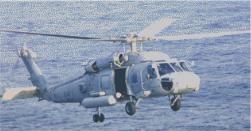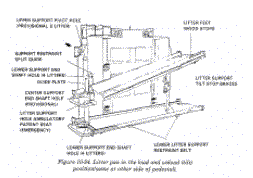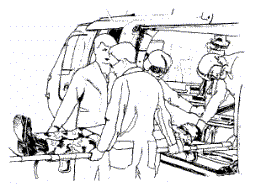|
The UH-60 is a twin-engine, medium lift,
utility or assault helicopter, used by the Army, Navy, Air Force and Coast
Guard.
Some versions, such as the Air Force's MH-60 G Pave Hawk and the
Coast Guard's HH-60J Jayhawk, are equipped with a rescue hoist with
a 250 foot (75 meter) cable that has a 600 pound (270 kg) lift capability,
and a retractable in-flight refueling probe. The Army's UH-60L Black
Hawk can carry 11 soldiers or 2,600 pounds (1,170 kg) of cargo or
sling load 9,000 pounds (4,050 kg) of cargo.
The Army uses Blackhawks as the primary dedicated air ambulance. The
typical medical evacuation configuration provides for four litter patients
and one ambulatory patient. Other configurations include: (Each allows
sufficient room for a crew chief and a medical aidman.)
|
Patient Configurations, UH-60A Medical
Evacuation Kit |
|
Four-Litter (Combat)
Configuration |
Six-Litter (High
Capacity) Configuration |
|
4 Litter patients
1 Ambulatory patient |
6 Litter patients
1 Ambulatory patient |
|
2 Litter patients
4 Ambulatory patients |
3 Litter patients
4 Ambulatory patients |
|
0 Litter patients
7 Ambulatory patients |
0 Litter patients
7 Ambulatory patients |
|
Patient Configurations, UH-60A Medical
Evacuation Kit with Internal Rescue Hoist Installed |
|
Four-Litter (Combat)
Configuration |
Six-Litter (High
Capacity) Configuration |
|
3 Litter patients
1 Ambulatory patient |
4 Litter patients
1 Ambulatory patient |
|
0 Litter patients
4 Ambulatory patients |
0 Litter patients
4 Ambulatory patients |
When configured for medical evacuation for 4 litter patients, there is
a center pedestal which can be rotated 90 degrees about the vertical axis
to facilitate loading and unloading litters. Patients can be loaded from
either side of the aircraft.
The normal aircrew for medical evacuation missions numbers four,
including a crew chief and medical aidman.
Patients are positioned in the aircraft according to the directions of
the aircrew:
-
Usually, the most seriously injured patients are loaded last on the
bottom pans of the litter support unit.
-
If in-flight emergency medical treatment is required, he should be
loaded into either of the top two pans.
-
Because of the cabin structure, patients receiving IV fluids can be
placed on any of the litter pans.
-
Patients with traction splints should be loaded last and on a bottom
pan.
-
Patients should be loaded so their heads are toward the front of the
aircraft.
-
Patients are unloaded in reverse order, the most serious first.
Approved for public release; Distribution is unlimited.
The listing of any non-Federal product in this CD is not an
endorsement of the product itself, but simply an acknowledgement of the source.
Operational Medicine 2001
Health Care in Military Settings
Bureau of Medicine and Surgery
Department of the Navy
2300 E Street NW
Washington, D.C
20372-5300 |
Operational Medicine
Health Care in Military Settings
CAPT Michael John Hughey, MC, USNR
NAVMED P-5139
January 1, 2001 |
United States Special Operations Command
7701 Tampa Point Blvd.
MacDill AFB, Florida
33621-5323 |
This web version is provided by
The Brookside Associates Medical Education Division.
It contains original contents from the official US Navy NAVMED P-5139, but has
been reformatted for web access and includes advertising and links that were not
present in the original version. This web version has not been approved by the
Department of the Navy or the Department of Defense. The presence of any
advertising on these pages does not constitute an endorsement of that product or
service by either the US Department of Defense or the Brookside Associates. The
Brookside Associates is a private organization, not affiliated with the United
States Department of Defense.
Contact Us · · Other Brookside
Products
|



